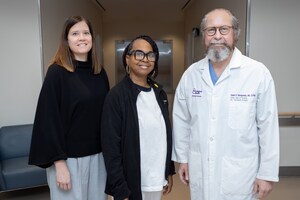Telemedicine "Blueprint" Introduced to Assess/Triage Covid-19 Patients
Virtual Physician Visits Limit Spread of Disease, Help Determine Health Risks to Patients
--NYU Long Island School of Medicine, NYU Langone Health, and NYU Grossman School of Medicine Collaborate on Protocols for Worldwide Adaptation in Urban Settings--
MINEOLA, N.Y., Sept. 10, 2020 /PRNewswire/ -- While Covid-19 patients who are unstable and in acute distress may need immediate in-person attention, many patients can be evaluated at home by telemedicine, thereby maintaining social distancing and reducing the spread of the disease. Limited guidance exists, however, for the remote delivery of healthcare, or "healing at a distance," though the need has risen significantly during the pandemic. Now medical experts affiliated with NYU Long Island School of Medicine and NYU Langone Health have collaborated to develop a template for remote Covid-19 healthcare delivery, including protocols for assessing and triaging patients who may be Covid-positive.
The spectrum of symptoms in persons infected with Covid-19 range from asymptomatic to severe and life-threatening; the more benign manifestations are often able to be managed from home. A new report, titled "A Telemedicine Approach to Covid-19 Assessment and Triage," published on September 10, 2020, in Medicina, a peer-reviewed scientific and medical journal, outlines protocols for assessing various patient symptoms through virtual means. The paper notes that these protocols are most easily applicable in settings that have adequate internet or phone connections, and that, when the technology is available, telehealth is also promising for delivery of care to persons living in remote areas where distance is a barrier to seeking help.
"Most physicians have never before practiced telemedicine, and in this new world of a pandemic, our guidelines serve as a blueprint for safe and effective Covid-19 assessments," said the report's lead author, Allison B. Reiss, MD, Associate Professor in the Department of Medicine at NYU Long Island School of Medicine and head of the Inflammation Laboratory at NYU Winthrop Hospital's Research Institute.
A virtual assessment of Covid-19 symptoms is more feasible than one might imagine, according to the report's authors. A "Decision-tree diagram" in the report helps direct practitioners in classifying the seriousness of the infectious disease, while numerous adaptations to the physical exam can help detect symptoms. The telemedicine physical exam, for example, includes observing the patient's breathing in order to detect "respiratory distress," i.e. whether the patient is having trouble breathing, a warning sign of a more serious Covid-19 infection. Dr. Reiss noted that respiratory issues can be discerned virtually by "looking, listening, and counting" a patient's respiratory rate and respiratory effort. A virtual viewing of the throat could be aided by a flashlight (a household member might assist). A patient exhibiting tenderness to the abdomen, upon their own touch, might indicate telltale Covid-related gastrointestinal issues, and so on.
The report's guidelines adhere to criteria established by the Centers for Disease Control (CDC), including for assessing the clinical stability of patients.
"The rapid expansion of telemedicine in response to the Covid-19 pandemic allows physicians to safely maintain connections to their patients in a way never before achieved—whether involving Covid-related or other medical issues," said Eric Goldberg, MD, Senior Medical Director, Department of Medicine at NYU Langone Health and Clinical Associate Professor, NYU Grossman School of Medicine. "Telemedicine can also create deeper connections between a physician and patient, emanating from the personal spaces shared by each."
The collaborating institutions on the report were actively using telemedicine protocols prior to the onset of the Covid-19 pandemic but saw a rise in daily visits from 50 in early March 2020 to more than 7,000 by April 2020—completing more than 550,000 video visits during the March-August time period. The report authors say that, ultimately, widespread adoption of this technological tool will be determined by formal studies of quality, comparing telehealth versus in-person outcomes.
About NYU Long Island School of Medicine/NYU Winthrop Hospital
NYU Long Island School of Medicine is New York University's flagship medical school on Long Island. The school offers tuition-free scholarships with an innovative, accelerated three-year curriculum exclusively devoted to training primary care physicians. The medical school is situated on the campus of NYU Winthrop Hospital, the Long Island hub of NYU Langone Health. NYU Winthrop Hospital is ranked by U.S. News & World Report as one of the top-10 New York metro-area hospitals and features more than 75 divisions of specialty care, offering comprehensive inpatient and outpatient programs and services to address every stage of life.
Contact:
Anne Kazel-Wilcox, Manager, Public Relations
NYU Winthrop Hospital/NYU Long Island School of Medicine
(516) 663-4999; [email protected]
SOURCE NYU Langone Health

Related Links
WANT YOUR COMPANY'S NEWS FEATURED ON PRNEWSWIRE.COM?
Newsrooms &
Influencers
Digital Media
Outlets
Journalists
Opted In






Share this article